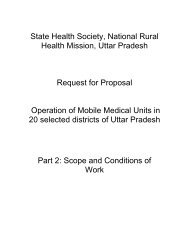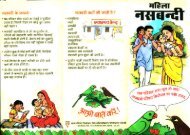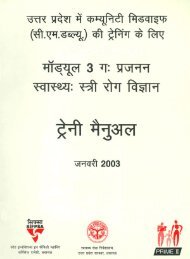MODULE 1: Infection Control and Waste Management - State ...
MODULE 1: Infection Control and Waste Management - State ...
MODULE 1: Infection Control and Waste Management - State ...
You also want an ePaper? Increase the reach of your titles
YUMPU automatically turns print PDFs into web optimized ePapers that Google loves.
4. If drums are being used, position items in drum to allow free circulation of steam.Items should not be kept in close containers inside the drum <strong>and</strong> the holes of theautoclave drum should be kept open while sterilizing.5. Arrange all packs or drums in autoclave <strong>and</strong> autoclave should be adjusted on121°C temperature <strong>and</strong> 15lbs/m 2 pressure for 30 minutes.6. Time with a clock or watch for 30 minutes. Do not begin timing unless thedesired temperature <strong>and</strong> pressure are achieved.7. After sterilization is complete, slowly release the steam <strong>and</strong> wait till the pressuregauze reaches zero <strong>and</strong> carefully open the lid of the autoclave maintaining adistance from the hot steam. Leave instrument packs or items in the autoclaveuntil they dry completely (which could take up to 30 minutes).8. Remove packets from autoclave, checking for dryness (Damp packs drawmicroorganisms from the environment <strong>and</strong> should be considered contaminated).9. Storage: Sterilized items that are wrapped are considered sterile till one week ifkept dry. Unwrapped items if kept in a covered container should be used within24 hours or should be kept in sterile airtight covered container up till one week.Before using any item, its wrapper should be checked for tears or holes. The itemswith torn wrappers should be considered as unsterile.Wrapping Instruments Gloves <strong>and</strong> other items for autoclaving• First, make sure that the instrument being wrapped is clean.• Take correct size wrapper for the instrument or item being wrapped.• Check the wrapper for holes, tears, lint, residue <strong>and</strong> defects using proper light.• Wrappers have to completely enclose the instrument or item being wrapped.• The edges need to be properly folded so the tool can be aseptically presentedduring a procedure.• While the edges <strong>and</strong> corners of the wrapper need to be tucked in, there should notbe excessive wrapping material on <strong>and</strong> around the item as this interferes with thesterilant's penetration.• Pins, staples, paperclips <strong>and</strong> other sharp objects should never be used to secure awrapped item. All sterile packages should be h<strong>and</strong>led as little as possible.34










